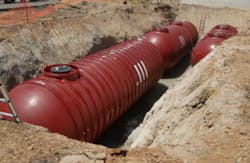WASHINGTON — The U.S Environmental Protection Agency (EPA) plans to strengthen requirements governing underground storage tanks (USTs) to prevent and detect leaks, according to a press release.
Leaks from USTs are a main cause of groundwater contamination, noted the release. The revisions will help to ensure all USTs meet the same standards.
“These changes will better protect people’s health and benefit the environment in communities across the country by improving prevention and detection of underground storage tank releases,” said Mathy Stanislaus, assistant administrator of EPA’s Office of Solid Waste and Emergency Response, in the release. “Extensive and meaningful collaboration with our underground storage tank partners and stakeholders was vital to the development of the new regulations. The revised requirements will also help ensure consistency in implementing the tanks program among states and on tribal lands.”
USTs on tribal lands must comply with the Energy Policy Act of 1995, reported the release. The requirements close regulatory gaps, add new technologies and focus and proper operations and maintenance of existing systems.
The release included the following revisions to the requirements:
- adding secondary containment requirements for new and replaced tanks and piping
- adding operator training requirements
- adding periodic operation and maintenance requirements for UST systems
- removing past deferrals for emergency generator tanks, airport hydrant systems, and field-constructed tanks
- adding new release prevention and detection technologies
- updating codes of practice
- updating state program approval requirements to incorporate these new changes
EPA developed the changes while balancing environmental benefits with costs for owners and operators, shared the release.
Click here to read the entire release.
